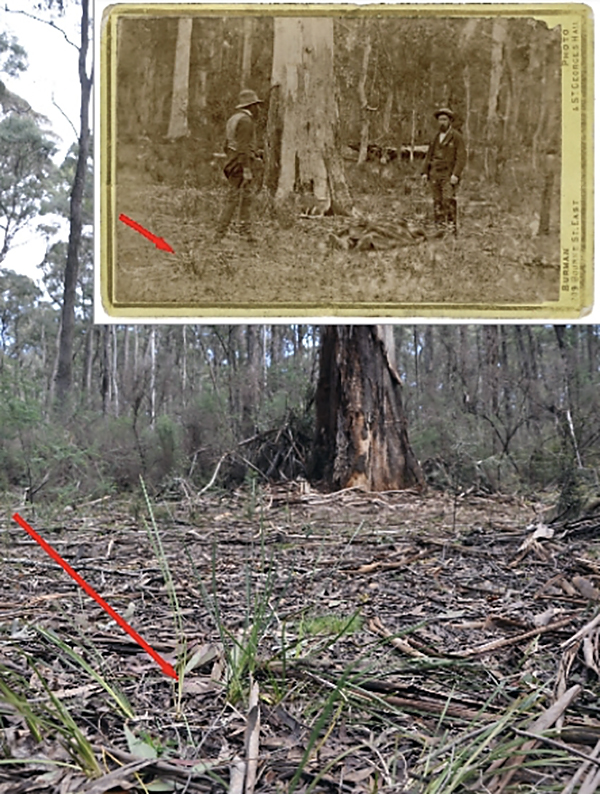Investigating THE KENNEDY TREE and POLICE CAMP SITEs
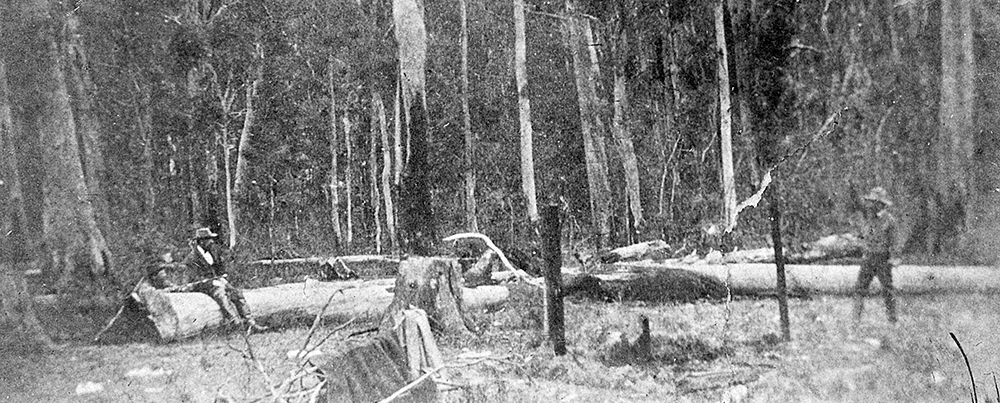
Presented on Saturday 14th December (10am – 1pm) at the Greta Hansonville Hall
Adrian Younger from Greta, Tony King from Lurg, Jim Fogarty from Melbourne and Noeleen Lloyd from Greta, have collected detailed data that will prove the locations of the Kennedy Tree and the Police Camp site at Stringybark Creek and they will finally reveal to the public their findings in person at a special presentation to be held in Greta, Victoria on December 14th. They believe their discoveries will provide the families of Sgt Kennedy and Constables Lonigan and Scanlan with definitive evidence and locations where they can remember and commemorate their ancestors.
The Kennedy Tree marked the spot where the body of Victoria Police’s Sergeant Michael Kennedy was found in October 1878 after being shot by Ned Kelly. Through the generations, these historically important sites have been lost, and over the last sixty years there has been much debate and many theories put forward as to the locations.
At the special presentation in Greta, The Kennedy Tree Report Team will explain the background to how the project began, how the project team was formed, and how they referenced historical records to analyse the two sites including looking at specifics such as orientation, plant life and topography. The team will also release detailed data collected from more than twenty significant trees in the Stringybark Creek precinct that will support their findings.
Background
When Adrian, Tony, Jim and Noeleen were convinced they had found the right location for the Kennedy Tree they thought finding the police camp site where Mounted Constables Lonigan and Scanlan were killed was a real possibility. ‘With the Kennedy tree still surviving it was possible other trees may have survived that can be seen in the 1878 police camp photo,’ Adrian said.
The question arose how far Sergeant Kennedy would be able to run when being chased if he was wounded and in pain. On one field trip, Adrian and Tony walked the area looking at anything that might fit in with the Burman photo such as trees, lay of the land and direction mentioned in previous historic reports. They discovered a tree that matched the tree on the right of the Burman photo and nicknamed this tree the ‘Teapot Tree’ because of its unusual shape to its upper branch. Another large tree slightly left of centre in the Burman photo appeared to be a forked tree and we noticed one existing in the new site that was a possible match.
Through Noeleen Lloyd they invited Jim Fogarty on board to provide horticultural insight and to report on the plant life and trees near the Kennedy Tree. Jim quickly became very interested in the other trees of interest that had been discovered. Analysing the Burman photo, he soon discovered two other trees in the background of the photo that matched their site.
‘With this new information at hand we realised we had located the Police Camp and the Kennedy Tree and connected both sites,’ Adrian said. ‘Over a period of four months we collected detailed data from over twenty significant trees along Stringybark Creek Road to document our findings. This has been a huge adventure for the four of us and a very time consuming one, but we realise the historical importance of what we have discovered. It gives us great pleasure to reveal these sites so that history can be preserved.’
The site the authors concluded as being the correct site of the police camp is on a clearing on a rise to the north of the current historic reserve, between the east side of Stringybark Creek Road and the creek. ‘The location is to the north of the hut marked on the 1884 survey. The ground is relatively flat, has a declivity to the creek toward the SE, is large enough to be “an acre or two” in area and is the most suitable location along the west bank of Stringybark Creek to set up camp where the ground is not sodden. The location comfortably fits the description of being 70 yards from the creek. The orientation, environment and vegetation all match that of the Burman photos.’
Adrian Younger, Tony King, Jim Fogarty, and Noeleen Lloyd believe their discovery will allow these historically important sites to be documented correctly and respectfully. On 26 October 2019, the 141st anniversary of the Stringybark Creek police killings, the group met with descendants of Sgt Kennedy and Constable Lonigan at the site to present their findings.
‘This has been a huge adventure for us and a very time consuming one, but we realise the historical importance of what we have discovered. It gives us great pleasure to reveal these sites so that history can be preserved.’
Adrian Younger, Tony King, Jim Fogarty, and Noeleen Lloyd [December 2019]
Download: Kennedy Tree Report
Download: Police Camp Report
Information: facebook.com/The-Kennedy-Tree-Report
Photo One:
Comparison between 1878 Burman photo (top) and 2019 photo (below). Both photos are oriented in an SSW direction looking back along Stringybark Creek Road with the north boundary fence of the current historic reserve approximately 160 metres to the south. Tree coded PC1 can be clearly seen to the right of both photos. PC2 aligns roughly with the centre of both photos (refer to red arrows). The starburst canopy of PC4 (yellow) can be seen in both photos although it is partly obscured in the 2019 photo (can be seen on site). The forked trunk of PC3 can be seen in both photos (blue arrow) and on site. We have estimated PC1 to be 111 years old in 1878 and 252 years old in 2019. Bottom photo credit: Younger, King, Fogarty, Lloyd 2019.
Police Camp
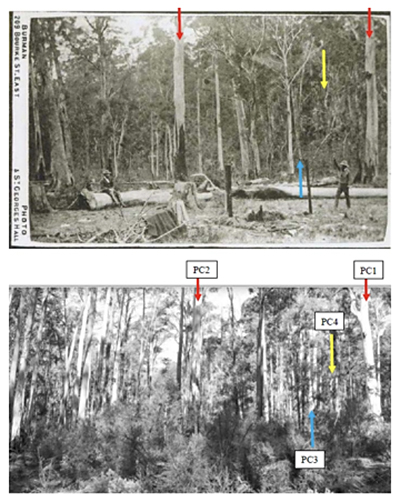
Photo Two:
A recreation of the 1878 Burman photo using scaled cardboard cut outs of the standing men that show in the original photo. The tree in the Burman photo has been estimated to be 229 years old (2019) and 88 years old in 1878. Of more than twenty aged trees along Stringybark Creek Road, the located tree (coded K1) is the closest match in age to the tree in Burman photo (within four years). As well as a blaze scar on the left (south facing) side of the tree, the lower buttress root outlines match the 1878 photo. Detailed similarities can be found in the Kennedy Tree Report. Photo credit: Younger, King, Fogarty, Lloyd 2019.
Kennedy Tree
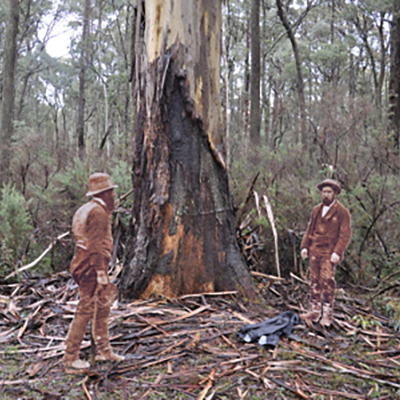
Photo Three:
This image was taken by Burman in October 1878. There is a weathered blaze on the left (south facing) side of the tree that predates the shootings. The authors conclude this weathered blaze places it as one of the blazed marker trees alongside the bridle track that is now Stringybark Creek Road.
Kennedy Tree
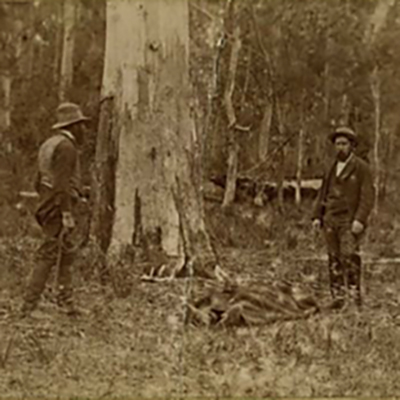
Photo Four:
A comparison image with the Burman photo 1878 on the left and a 2019 comparison on the right. The mark ups by Tony King depict key similarities between the two trees. Both trees are Eucalyptus viminalis or Manna Gum.
Kennedy Tree
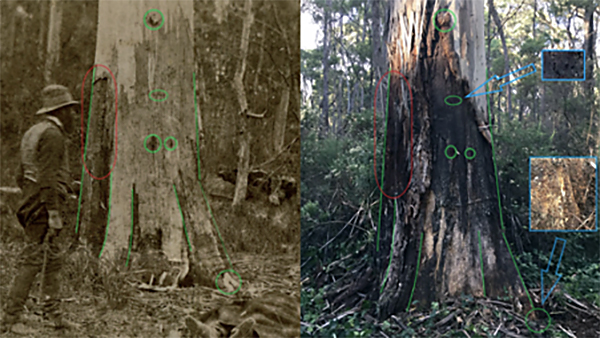
Photo Five:
The site showing Lepidosperma laterale, a small evergreen tuft, that can be clearly seen in the 1878 Burman photo (inset) and still growing on site today. Main photo credit: Younger, King, Fogarty, and Lloyd 2019.
Kennedy Tree
